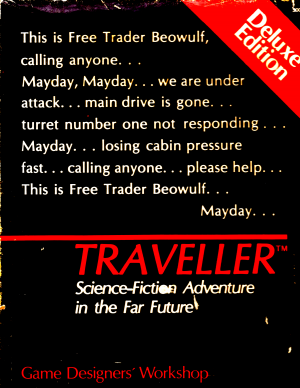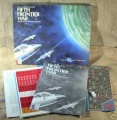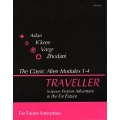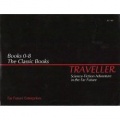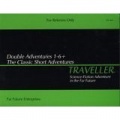Difference between revisions of "Classic Traveller"
(Duplicate text spotted in section 1 of 4) |
|||
| (18 intermediate revisions by 7 users not shown) | |||
| Line 1: | Line 1: | ||
| + | <translate> | ||
| + | <!--T:1--> | ||
[[File:Trav.cover.png|thumb|Deluxe Edition Box Front|right]] | [[File:Trav.cover.png|thumb|Deluxe Edition Box Front|right]] | ||
| − | ''[[Classic Traveller|Traveller]]'', sometimes referred to as Classic Traveller, is the original edition and was published between 1977 and 1986. | + | ''[[Classic Traveller|Traveller]]'', sometimes referred to as Classic Traveller, is the original edition and was published between 1977 and 1986. This edition is known for its "[[Little Black Book|little black book]]s"; most of the rules and supplements came as mostly black with a single offset color. The Adventures and supplements for this edition start in [[1105]] and advance through [[1115]]. |
| − | |||
| − | |||
| − | |||
| − | |||
| − | + | <!--T:2--> | |
| − | + | This article refers to specific information about this edition, for information about the game in general please refer to the [[Versions of Traveller]]. | |
| − | The game | + | == Description ([[Specifications]]) == <!--T:3--> |
| + | The game system introduced a unique character generation system that helped it to stand out from other role-playing games of the time. Players took their characters through a career development path (usually in the military) where the player rolled for different assignments and gained extra skills, rank and retirement benefits. Leaving a character in service for longer before the game would lead to more skills and beginning cash but could also mean that basic attributes (such as strength) would begin to degrade with old age. | ||
| − | + | <!--T:4--> | |
| − | The | + | Characters could die or be injured before a player finished rolling them up. The game became known for this character generation system. |
| − | The | + | === Overview === <!--T:5--> |
| + | The Classic Traveller core rules were published in three different rulesets. | ||
| − | + | <!--T:6--> | |
| + | The original 1977 release of Traveller contained three books – [[Characters and Combat]], [[Starships]], and [[Worlds and Adventures]]. This set of rules contains everything needed to play Traveller. In 1981, [[GDW]] took advantage of a need to reprint the core rules to make revisions. This "second edition" both added and removed details and incorporated errata printed in [[Mercenary (book)|Mercenary]] for the original 1977 edition. | ||
| − | + | <!--T:7--> | |
| − | + | The second edition was repackaged in a folio edition [[The Traveller Book]] in 1982, along with additional material including a few added rules, a special introduction for new players, two adventures, and details on what was becoming the [[Official Traveller Universe]] (OTU). | |
| − | |||
| − | |||
| − | |||
| − | |||
| − | |||
| − | |||
| − | |||
| − | |||
| − | |||
| − | |||
| − | |||
| − | |||
| − | |||
| − | |||
| − | |||
| − | |||
| − | === Popular Artists & Authors === | + | <!--T:8--> |
| + | Finally, in 1983, [[GDW]] released [[Starter Traveller]], intended at giving a younger audience a streamlined and simpler set of Traveller rules. This release was published as a boxed set with the three main [[Little Black Book|little black books]]. This version used most of the text from the 1981 edition but simplified some of the more complex rules, including a simplified space combat system that uses range bands instead of 2D vectors. | ||
| + | |||
| + | ===Additional Books, Adventures, Supplements, and Modules=== | ||
| + | |||
| + | Between 1979 and 1986, GDW released five more rule books in the same [[Little Black Book|little black book]] format using varying colors in the covers to set them apart. These gave more detailed rules on character generation along with more detailed design rules for warships, star systems and robots. | ||
| + | |||
| + | During this same period, GDW released 13 numbered adventure books as [[Little Black Book|little black books]]. They also released 6 numbered "Double Adventure" books in a similar format but bound back to front; the reader would have to flip the book over to read the second adventure. These adventures were intended to be standalone issues, not necessarily part of an overall campaign. In 1983 GDW published [[The Traveller Adventure|"The Traveller Adventure"]], a full campaign in the same format and in the same style as [[The Traveller Book]]. | ||
| + | |||
| + | GDW also released 13 numbered supplements in a similar format to the adventures, with a different color scheme on the cover of each. Some of these are intended to reduce a referee's workload by providing adventure hooks, pregenerated characters, and predesigned ships, but others include the first details published about the [[Official Traveller Universe]] (OTU), including two full sectors. | ||
| + | |||
| + | In addition, GDW published 8 Alien Modules, each detailing a different race. The last three of these were published in 1986 and 1987, putting them well within the [[MegaTraveller]] time period. | ||
| + | |||
| + | The complete Classic Traveller would include all of these works. | ||
| + | |||
| + | === Popular Artists & Authors === <!--T:9--> | ||
ARTISTS: | ARTISTS: | ||
| − | * | + | * [[David Deitrick]] |
| + | * [[Jennell Jaquays]] | ||
| + | <!--T:10--> | ||
AUTHORS: | AUTHORS: | ||
* [[Marc Miller]] | * [[Marc Miller]] | ||
* [[Loren Wiseman]] | * [[Loren Wiseman]] | ||
| − | == History & Background (Dossier) == | + | == History & Background ([[Dossier]]) == <!--T:11--> |
| − | [[Classic Traveller]] was replaced in 1986 by a new version | + | [[Classic Traveller]] was replaced in 1986 by a new version called [[MegaTraveller]] which not only radically revised the mechanics of the game with a standardized task based system, but also the format of publication in folio-sized books with full color cover art. The background [[setting]] ([[timeline]]) was advanced several years into a shattered [[Third Imperium]] fighting a [[Civil War]]). |
| + | |||
| + | === Meta-history & Background === <!--T:12--> | ||
| + | ''Etymology:'' The word ''[[Traveller Gene|Traveler]]'' and its British [[English]] orthographic variation ''Traveller'' refer to individuals who ''travel''. In practice this refers to tourists, nomads, gypsies, exiled or expatriate peoples, and the like. In the ''Traveller RPG universe'', it refers to [[sophont]]s who ''travel the stars'', a special group of beings with an adventurous spirit. | ||
| − | + | <!--T:13--> | |
| − | + | At the beginning there was only some very basic background material to the Traveller universe. It appeared that like most other RPG games of the time, individual game masters would develop their own universe to adventure in. It was originally intended to be a flexible, multi-purpose, general ruleset. As more adventures and supplements were developed, the rich character of the standard Traveller universe began to evolve. | |
| − | + | <!--T:14--> | |
| − | + | Most of the Classic Traveller books are available in compendium volumes from [http://www.farfuture.net www.farfuture.net] - Marc Miller's Far Future company, who are the current copyright and trademark holder of all forms of the Traveller game. | |
| − | === Bibliography-Ludography (Published Products) === | + | === Bibliography-Ludography (Published Products) === <!--T:15--> |
This edition is best known for the following products: | This edition is best known for the following products: | ||
{{BookImageList}} | {{BookImageList}} | ||
| − | === External Links === | + | === External Links === <!--T:16--> |
Here are some additional links: | Here are some additional links: | ||
| − | # | + | # [[Classic Traveller Bibliography]] |
| − | # | + | # [[Publications]] |
| − | # | + | # [http://www.waynesbooks.com/CTLittleBlackBooks.html Wayne's "The Little Black Books" - Classic Traveller] |
| − | # | + | # [https://docs.google.com/document/d/1jsH-EgKvaR0mdbtJMj_Xj7X3TcYyZTqQGf-Gwu58PX0/edit?usp=sharing "Traveller Section by Section Comparison"] |
| − | == References & Contributions (Sources) == | + | == References & Contributions ([[Sources]]) == <!--T:17--> |
{{Wikipedia|Classic_Traveller}} | {{Wikipedia|Classic_Traveller}} | ||
{{Intermediate}} | {{Intermediate}} | ||
| − | |||
{{Sources | {{Sources | ||
| − | + | |S2= Contributor: Lord (Marquis) and Master of Sophontology [[User:Maksim-Smelchak|Maksim-Smelchak]] of the [[Ministry of Science]] | |
| − | |S2= | ||
}} | }} | ||
| − | + | <!--T:18--> | |
[[Category: Versions]] | [[Category: Versions]] | ||
{{MET|}} | {{MET|}} | ||
| + | </translate> | ||
Latest revision as of 16:11, 14 November 2021
Traveller, sometimes referred to as Classic Traveller, is the original edition and was published between 1977 and 1986. This edition is known for its "little black books"; most of the rules and supplements came as mostly black with a single offset color. The Adventures and supplements for this edition start in 1105 and advance through 1115.
This article refers to specific information about this edition, for information about the game in general please refer to the Versions of Traveller.
Description (Specifications)[edit]
The game system introduced a unique character generation system that helped it to stand out from other role-playing games of the time. Players took their characters through a career development path (usually in the military) where the player rolled for different assignments and gained extra skills, rank and retirement benefits. Leaving a character in service for longer before the game would lead to more skills and beginning cash but could also mean that basic attributes (such as strength) would begin to degrade with old age.
Characters could die or be injured before a player finished rolling them up. The game became known for this character generation system.
Overview[edit]
The Classic Traveller core rules were published in three different rulesets.
The original 1977 release of Traveller contained three books – Characters and Combat, Starships, and Worlds and Adventures. This set of rules contains everything needed to play Traveller. In 1981, GDW took advantage of a need to reprint the core rules to make revisions. This "second edition" both added and removed details and incorporated errata printed in Mercenary for the original 1977 edition.
The second edition was repackaged in a folio edition The Traveller Book in 1982, along with additional material including a few added rules, a special introduction for new players, two adventures, and details on what was becoming the Official Traveller Universe (OTU).
Finally, in 1983, GDW released Starter Traveller, intended at giving a younger audience a streamlined and simpler set of Traveller rules. This release was published as a boxed set with the three main little black books. This version used most of the text from the 1981 edition but simplified some of the more complex rules, including a simplified space combat system that uses range bands instead of 2D vectors.
Additional Books, Adventures, Supplements, and Modules[edit]
Between 1979 and 1986, GDW released five more rule books in the same little black book format using varying colors in the covers to set them apart. These gave more detailed rules on character generation along with more detailed design rules for warships, star systems and robots.
During this same period, GDW released 13 numbered adventure books as little black books. They also released 6 numbered "Double Adventure" books in a similar format but bound back to front; the reader would have to flip the book over to read the second adventure. These adventures were intended to be standalone issues, not necessarily part of an overall campaign. In 1983 GDW published "The Traveller Adventure", a full campaign in the same format and in the same style as The Traveller Book.
GDW also released 13 numbered supplements in a similar format to the adventures, with a different color scheme on the cover of each. Some of these are intended to reduce a referee's workload by providing adventure hooks, pregenerated characters, and predesigned ships, but others include the first details published about the Official Traveller Universe (OTU), including two full sectors.
In addition, GDW published 8 Alien Modules, each detailing a different race. The last three of these were published in 1986 and 1987, putting them well within the MegaTraveller time period.
The complete Classic Traveller would include all of these works.
Popular Artists & Authors[edit]
ARTISTS:
AUTHORS:
History & Background (Dossier)[edit]
Classic Traveller was replaced in 1986 by a new version called MegaTraveller which not only radically revised the mechanics of the game with a standardized task based system, but also the format of publication in folio-sized books with full color cover art. The background setting (timeline) was advanced several years into a shattered Third Imperium fighting a Civil War).
Meta-history & Background[edit]
Etymology: The word Traveler and its British English orthographic variation Traveller refer to individuals who travel. In practice this refers to tourists, nomads, gypsies, exiled or expatriate peoples, and the like. In the Traveller RPG universe, it refers to sophonts who travel the stars, a special group of beings with an adventurous spirit.
At the beginning there was only some very basic background material to the Traveller universe. It appeared that like most other RPG games of the time, individual game masters would develop their own universe to adventure in. It was originally intended to be a flexible, multi-purpose, general ruleset. As more adventures and supplements were developed, the rich character of the standard Traveller universe began to evolve.
Most of the Classic Traveller books are available in compendium volumes from www.farfuture.net - Marc Miller's Far Future company, who are the current copyright and trademark holder of all forms of the Traveller game.
Bibliography-Ludography (Published Products)[edit]
This edition is best known for the following products:
External Links[edit]
Here are some additional links:
- Classic Traveller Bibliography
- Publications
- Wayne's "The Little Black Books" - Classic Traveller
- "Traveller Section by Section Comparison"
References & Contributions (Sources)[edit]
| This page uses content from Wikipedia. The original article was at Classic_Traveller. The list of authors can be seen in the page history. The text of Wikipedia is available under the Commons Attribution-ShareAlike 3.0 Unported License. |
- Contributor: Lord (Marquis) and Master of Sophontology Maksim-Smelchak of the Ministry of Science
